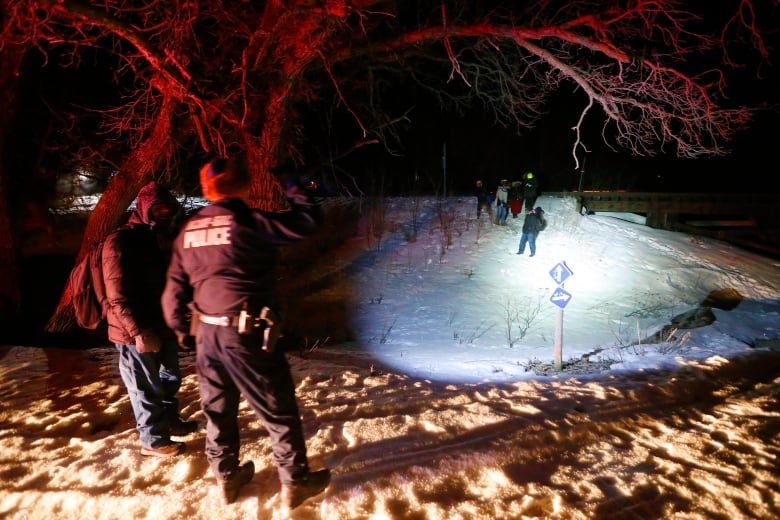Listening for a story: What it's like to stake out the border for asylum seekers
CBC News reporter followed 6 men and a woman from Somalia on their walk into Canada near Emerson, Man.

The cold –20 C air pours into the CBC Caravan as we roll down the window so we can listen for asylum seekers sneaking into Canada.
We'd have a better chance of hearing them talk to each other than spotting them in the dark, we'd been told.
It was 1 a.m. when Radio-Canada cameraman Thomas Asselin and I pulled up to the spot we staked out within a stone's throw of the Manitoba-U.S. border.
A steady trickle of people have come into Canada in the area over the past few months, walking for hours through farmers' fields so they don't get turned back by border officials at the official port of entry.
We flashed our high beams a few times. In front of us was a set of train tracks running along some brush on the southeast edge of Emerson.
- 7 more asylum seekers walk into Manitoba, where it's –20 C
- UN lawyer to visit Manitoba to observe influx of asylum seekers
The tracks run straight into Canada from the U.S., then turn to run parallel to the border through the edge of town.
A fire department volunteer told us it was a good place to start: earlier that week a group of people from Somalia and Djibouti were found crossing in the vicinity.
It was Saturday night, and even though the largest waves of people seemed to be making the trek into Canada on the weekend, the chance of finding them, given the vast area, seemed increasingly slim.

Hours went by. The only action was a roving RCMP officer with the border protection unit, doing his rounds.
"Nothing yet," he told us as he passed.
It was after 4 a.m. I closed my eyes just to listen.
Nothing.
When I opened them, though, I thought I saw a shadow move in the distance, near an old building on the U.S. side.
I didn't even mention it to Thomas. It was probably a deer, I thought.
Shadows along the brush
At 4:30 a.m., I saw another shadow move along the brush. Then another one, and another.
"I think those are people," I said and immediately got out of the car and headed towards them.
"Hello, do you speak English?" I called out. "We're journalists. Are you ok?"
Nobody answered. They looked cold and scared. Six men and one woman, wearing a cotton skirt with leggings, moved quicker now along the tracks.

Unsure if they spoke English, we called the RCMP and then caught up with them on the tracks a few blocks ahead.
"We are okay," a young man from Somalia told us as we approached.
"How long have you been walking?" I asked. He paused.
"Probably 22 hours," he said.
His eyelashes, scarf and hat were covered in frost.
'This is Canada?'
"Where did you walk from? Are you travelling with your family? Do you know you're in Canada?"
He told us he took a bus from Minnesota to North Dakota and a taxi dropped him somewhere near the border. He didn't know the others, he said. He met them along the way.
Walking on the tracks is difficult. The railway ties are spread out, it's dark, and there are spikes and nails tripping people as we go.
"What is it like to know you've crossed, you're here?" I asked him.
"This is Canada?" he asked in disbelief. "I feel safe," he said.
By this time, I didn't. We were making our way onto a railway overpass with a road 15-feet below. It was dark and slippery, with nothing but a drop to the ground between the gaping beams and no railing to steady us.
I watched the woman in front of me move carefully in her skirt. A man held onto her as they crossed.
An RCMP officer came down the tracks behind us with a flashlight. When we got to the other side, we could see the red and blue flashing lights of a police truck in the distance.
Fear of Trump
"Why did you want to come to Canada?" we asked the man.
His journey began in 2015. He fled Somalia after his father and brother were murdered. He made his way to Kenya, then Lagos before arriving in Costa Rica, he said. He crossed up to Mexico and then into Texas, where he was detained for two months. Upon release, he headed for Minnesota.
"Mr. Trump, he said, 'I am going to deport Somalis,' so I decided to [come] to Canada," he told us.
Asylum seekers are sneaking into Canada because if they try to enter at an official border crossing, they'll likely be turned back under the Safe Third Party Agreement with the U.S. Asylum seekers who have successfully entered Canada have the right to make refugee claims under international law.

One by one, the asylum seekers make their way down an embankment to the police.
They line up outside the RCMP van and an officer asks if they understand they're all under arrest for illegally crossing into Canada.
They pile into the van, their scared faces seeming a bit more relieved.
The group is then escorted to the Canada Border Services Agency, where they will spend hours filling out refugee claims.
The young man from Somalia didn't give me his name and I don't know if he'll get to stay in Canada, but I do know I won't forget the relief in his eyes when he said "I feel proud to be here."

